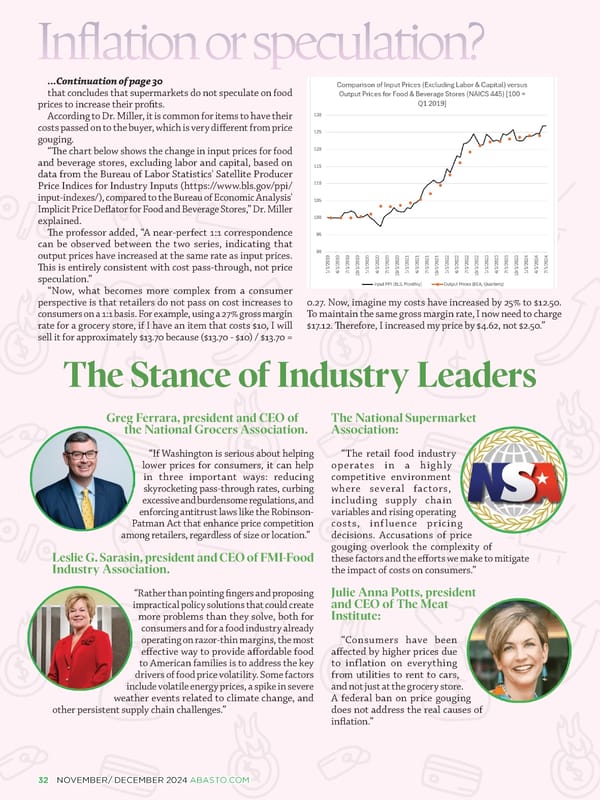In昀氀ation or speculation? ...Continuation of page 30 that concludes that supermarkets do not speculate on food prices to increase their pro昀椀ts. According to Dr. Miller, it is common for items to have their costs passed on to the buyer, which is very di昀昀erent from price gouging. “吀栀e chart below shows the change in input prices for food and beverage stores, excluding labor and capital, based on data from the Bureau of Labor Statistics' Satellite Producer Price Indices for Industry Inputs (https://www.bls.gov/ppi/ input-indexes/), compared to the Bureau of Economic Analysis' Implicit Price De昀氀ator for Food and Beverage Stores,” Dr. Miller explained. 吀栀e professor added, “A near-perfect 1:1 correspondence can be observed between the two series, indicating that output prices have increased at the same rate as input prices. 吀栀is is entirely consistent with cost pass-through, not price speculation.” “Now, what becomes more complex from a consumer perspective is that retailers do not pass on cost increases to 0.27. Now, imagine my costs have increased by 25% to $12.50. consumers on a 1:1 basis. For example, using a 27% gross margin To maintain the same gross margin rate, I now need to charge rate for a grocery store, if I have an item that costs $10, I will $17.12. 吀栀erefore, I increased my price by $4.62, not $2.50.” sell it for approximately $13.70 because ($13.70 - $10) / $13.70 = The Stance of Industry Leaders Greg Ferrara, president and CEO of The National Supermarket the National Grocers Association. Association: “If Washington is serious about helping “The retail food industry lower prices for consumers, it can help operates in a highly in three important ways: reducing competitive environment skyrocketing pass-through rates, curbing where several factors, excessive and burdensome regulations, and including supply chain enforcing antitrust laws like the Robinson- variables and rising operating Patman Act that enhance price competition costs, influence pricing among retailers, regardless of size or location.” decisions. Accusations of price gouging overlook the complexity of Leslie G. Sarasin, president and CEO of FMI-Food these factors and the e昀昀orts we make to mitigate Industry Association. the impact of costs on consumers.” “Rather than pointing 昀椀ngers and proposing Julie Anna Potts, president impractical policy solutions that could create and CEO of The Meat more problems than they solve, both for Institute: consumers and for a food industry already operating on razor-thin margins, the most “Consumers have been e昀昀ective way to provide a昀昀ordable food a昀昀ected by higher prices due to American families is to address the key to inflation on everything drivers of food price volatility. Some factors from utilities to rent to cars, include volatile energy prices, a spike in severe and not just at the grocery store. weather events related to climate change, and A federal ban on price gouging other persistent supply chain challenges.” does not address the real causes of in昀氀ation.” 3232 NNOOVVEEMMBBEERR/ D/ DECECEEMMBBEER 2R 200224 4 AABBAASSTOTO..CCOOMM
 Abasto Magazine: November/ December 2024 - ENGLISH Page 31 Page 33
Abasto Magazine: November/ December 2024 - ENGLISH Page 31 Page 33